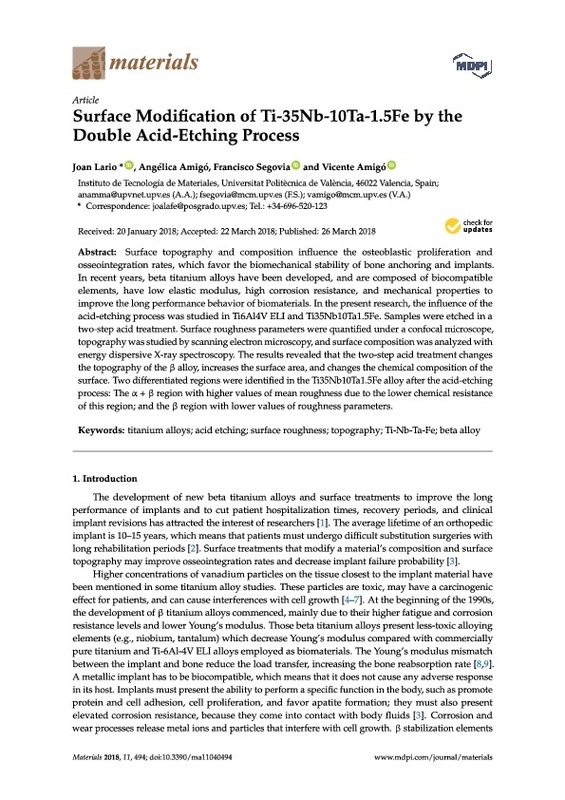Lario-Femenía, J., Amigó-Mata, A., Vicente-Escuder, Á., Segovia-López, F., & Amigó-Borrás, V. (2016). Desarrollo de las aleaciones de titanio y tratamientos superficiales para incrementar la vida útil de los implantes. Revista de Metalurgia, 52(4), 084. doi:10.3989/revmetalm.084
Kim, E.-S., Jeong, Y.-H., Choe, H.-C., & Brantley, W. A. (2013). Formation of titanium dioxide nanotubes on Ti–30Nb–xTa alloys by anodizing. Thin Solid Films, 549, 141-146. doi:10.1016/j.tsf.2013.08.058
Okazaki, Y., & Gotoh, E. (2005). Comparison of metal release from various metallic biomaterials in vitro. Biomaterials, 26(1), 11-21. doi:10.1016/j.biomaterials.2004.02.005
[+]
Lario-Femenía, J., Amigó-Mata, A., Vicente-Escuder, Á., Segovia-López, F., & Amigó-Borrás, V. (2016). Desarrollo de las aleaciones de titanio y tratamientos superficiales para incrementar la vida útil de los implantes. Revista de Metalurgia, 52(4), 084. doi:10.3989/revmetalm.084
Kim, E.-S., Jeong, Y.-H., Choe, H.-C., & Brantley, W. A. (2013). Formation of titanium dioxide nanotubes on Ti–30Nb–xTa alloys by anodizing. Thin Solid Films, 549, 141-146. doi:10.1016/j.tsf.2013.08.058
Okazaki, Y., & Gotoh, E. (2005). Comparison of metal release from various metallic biomaterials in vitro. Biomaterials, 26(1), 11-21. doi:10.1016/j.biomaterials.2004.02.005
Niinomi, M. (1998). Mechanical properties of biomedical titanium alloys. Materials Science and Engineering: A, 243(1-2), 231-236. doi:10.1016/s0921-5093(97)00806-x
Niinomi, M. (2008). Mechanical biocompatibilities of titanium alloys for biomedical applications. Journal of the Mechanical Behavior of Biomedical Materials, 1(1), 30-42. doi:10.1016/j.jmbbm.2007.07.001
Long, M., & Rack, H. . (1998). Titanium alloys in total joint replacement—a materials science perspective. Biomaterials, 19(18), 1621-1639. doi:10.1016/s0142-9612(97)00146-4
Eisenbarth, E., Velten, D., Müller, M., Thull, R., & Breme, J. (2004). Biocompatibility of β-stabilizing elements of titanium alloys. Biomaterials, 25(26), 5705-5713. doi:10.1016/j.biomaterials.2004.01.021
Navarro Laboulais, J., Amigó Mata, A., Amigó Borrás, V., & Igual Muñoz, A. (2017). Electrochemical characterization and passivation behaviour of new beta-titanium alloys (Ti35Nb10Ta-xFe). Electrochimica Acta, 227, 410-418. doi:10.1016/j.electacta.2016.12.125
Le Guéhennec, L., Soueidan, A., Layrolle, P., & Amouriq, Y. (2007). Surface treatments of titanium dental implants for rapid osseointegration. Dental Materials, 23(7), 844-854. doi:10.1016/j.dental.2006.06.025
Cremasco, A., Messias, A. D., Esposito, A. R., Duek, E. A. de R., & Caram, R. (2011). Effects of alloying elements on the cytotoxic response of titanium alloys. Materials Science and Engineering: C, 31(5), 833-839. doi:10.1016/j.msec.2010.12.013
Matsuno, H. (2001). Biocompatibility and osteogenesis of refractory metal implants, titanium, hafnium, niobium, tantalum and rhenium. Biomaterials, 22(11), 1253-1262. doi:10.1016/s0142-9612(00)00275-1
Jeong, Y.-H., Kim, W.-G., Choe, H.-C., & Brantley, W. A. (2014). Control of nanotube shape and morphology on Ti–Nb(Ta)–Zr alloys by varying anodizing potential. Thin Solid Films, 572, 105-112. doi:10.1016/j.tsf.2014.09.057
Aparicio, C., Padrós, A., & Gil, F.-J. (2011). In vivo evaluation of micro-rough and bioactive titanium dental implants using histometry and pull-out tests. Journal of the Mechanical Behavior of Biomedical Materials, 4(8), 1672-1682. doi:10.1016/j.jmbbm.2011.05.005
Choe, H.-C., Kim, W.-G., & Jeong, Y.-H. (2010). Surface characteristics of HA coated Ti-30Ta-xZr and Ti-30Nb-xZr alloys after nanotube formation. Surface and Coatings Technology, 205, S305-S311. doi:10.1016/j.surfcoat.2010.08.020
PYPEN, C. M. J. M., PLENK Jr, H., EBEL, M. F., SVAGERA, R., & WERNISCH, J. (1997). Journal of Materials Science Materials in Medicine, 8(12), 781-784. doi:10.1023/a:1018568830442
Cochran, D. L., Schenk, R. K., Lussi, A., Higginbottom, F. L., & Buser, D. (1998). Bone response to unloaded and loaded titanium implants with a sandblasted and acid-etched surface: A histometric study in the canine mandible. Journal of Biomedical Materials Research, 40(1), 1-11. doi:10.1002/(sici)1097-4636(199804)40:1<1::aid-jbm1>3.0.co;2-q
WEN, H. B., LIU, Q., DE WIJN, J. R., DE GROOT, K., & CUI, F. Z. (1998). Journal of Materials Science Materials in Medicine, 9(3), 121-128. doi:10.1023/a:1008859417664
Duraccio, D., Mussano, F., & Faga, M. G. (2015). Biomaterials for dental implants: current and future trends. Journal of Materials Science, 50(14), 4779-4812. doi:10.1007/s10853-015-9056-3
Frank, M. J., Walter, M. S., Lyngstadaas, S. P., Wintermantel, E., & Haugen, H. J. (2013). Hydrogen content in titanium and a titanium–zirconium alloy after acid etching. Materials Science and Engineering: C, 33(3), 1282-1288. doi:10.1016/j.msec.2012.12.027
Gil, F. J., Manzanares, N., Badet, A., Aparicio, C., & Ginebra, M.-P. (2013). Biomimetic treatment on dental implants for short-term bone regeneration. Clinical Oral Investigations, 18(1), 59-66. doi:10.1007/s00784-013-0953-z
Ban, S., Iwaya, Y., Kono, H., & Sato, H. (2006). Surface modification of titanium by etching in concentrated sulfuric acid. Dental Materials, 22(12), 1115-1120. doi:10.1016/j.dental.2005.09.007
KARAGEORGIOU, V., & KAPLAN, D. (2005). Porosity of 3D biomaterial scaffolds and osteogenesis. Biomaterials, 26(27), 5474-5491. doi:10.1016/j.biomaterials.2005.02.002
Le Guehennec, L., Lopez-Heredia, M.-A., Enkel, B., Weiss, P., Amouriq, Y., & Layrolle, P. (2008). Osteoblastic cell behaviour on different titanium implant surfaces. Acta Biomaterialia, 4(3), 535-543. doi:10.1016/j.actbio.2007.12.002
ANSELME, K., & BIGERELLE, M. (2005). Topography effects of pure titanium substrates on human osteoblast long-term adhesion. Acta Biomaterialia, 1(2), 211-222. doi:10.1016/j.actbio.2004.11.009
Anselme, K., Bigerelle, M., Noel, B., Dufresne, E., Judas, D., Iost, A., & Hardouin, P. (2000). Qualitative and quantitative study of human osteoblast adhesion on materials with various surface roughnesses. Journal of Biomedical Materials Research, 49(2), 155-166. doi:10.1002/(sici)1097-4636(200002)49:2<155::aid-jbm2>3.0.co;2-j
Herrero-Climent, M., Lázaro, P., Vicente Rios, J., Lluch, S., Marqués, M., Guillem-Martí, J., & Gil, F. J. (2013). Influence of acid-etching after grit-blasted on osseointegration of titanium dental implants: in vitro and in vivo studies. Journal of Materials Science: Materials in Medicine, 24(8), 2047-2055. doi:10.1007/s10856-013-4935-0
Mendonça, G., Mendonça, D. B. S., Aragão, F. J. L., & Cooper, L. F. (2008). Advancing dental implant surface technology – From micron- to nanotopography. Biomaterials, 29(28), 3822-3835. doi:10.1016/j.biomaterials.2008.05.012
Jayaraman, M., Meyer, U., Bühner, M., Joos, U., & Wiesmann, H.-P. (2004). Influence of titanium surfaces on attachment of osteoblast-like cells in vitro. Biomaterials, 25(4), 625-631. doi:10.1016/s0142-9612(03)00571-4
Park, J. Y., & Davies, J. E. (2000). Red blood cell and platelet interactions with titanium implant surfaces. Clinical Oral Implants Research, 11(6), 530-539. doi:10.1034/j.1600-0501.2000.011006530.x
ELIAS, C., OSHIDA, Y., LIMA, J., & MULLER, C. (2008). Relationship between surface properties (roughness, wettability and morphology) of titanium and dental implant removal torque. Journal of the Mechanical Behavior of Biomedical Materials, 1(3), 234-242. doi:10.1016/j.jmbbm.2007.12.002
[-]









